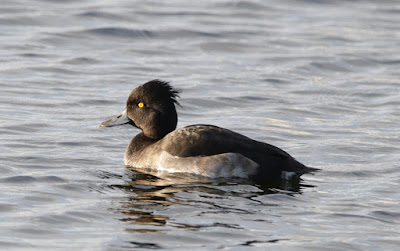Most bird ringers will agree that going to the same place on consecutive days may not be a good idea. That’s probably true for sites where the majority of birds are likely to be from a small local area but does not apply where a site attracts migratory birds, ones that are likely to be different individuals each day. And the theory definitely doesn't hold water in migrant hot-spots like coastal bird observatories where both ringing and observations on consecutive days is an absolute must to record day to day variations.
I guess our site up at Oakenclough is a mixture of the above. For sure there are local birds but located as it is on the edge of the Pennines and with a clear view down to the coast just 12 miles away, there can be a large element of migration at certain times of the year.
Andy and I had already been twice this week and clocked up almost 80 new birds, the latest on Thursday when we caught 52 of 10 species. So we had no qualms about heading up there again this morning and arranged our meet-up for 0630.
Thursday was a pretty busy day but this morning produced a downturn in both numbers caught and species observed. Birds ringed 23. We processed 7 Goldfinch, 3 Chaffinch, 3 Long-tailed Tit, 3 Coal Tit, 2 Tree Pipit and singles each of Blackcap, Robin, Great Tit, Goldcrest and Wren.
Today saw our ninth Tree Pipit of the week. All nine have been first year (born 2018) birds.
Tree Pipit
After three new Coal Tits yesterday, two more today tells us that the species’ migration is probably under way.
Coal Tit
Long-tailed Tits are definitely local birds. But we have not seen any large flocks of “lotties” just yet, flights that can number up to twenty, thirty or more individuals following good breeding success and mild winters.
Long-tailed Tit
Although we caught just the one Goldcrest today, there is little doubt that their autumnal migration is now on-going.
Goldcrest
We didn't record Willow Warbler today; our only warbler sighting consisted of the single Blackcap we caught, a first year male. Although Blackcaps breed close to this ringing site we are pretty sure that the three first years birds caught this week have been migrants.
Blackcap
This morning gave a good display of Chaffinch visible migration as small parties of between 2 and 20 individuals arrived from North and North West, flying overhead calling. From the total of approximately 80 observed, A small number stopped off and accounted for the three caught.
Chaffinch
About the only other visible migrant today was Swallow. Like the Chaffinches that moved in a similar time frame our Swallow sightings consisted of small parties of between 5 and 15 Swallows all heading south, either directly through or over the ringing site.
Otherwise: 1 Buzzard, 1 Kestrel, 1 Spotted Flycatcher, 10 Pied Wagtail.
Linking today to Stewart's World Bird Wednesday and http://id-rather-b-birdin.blogspot.com.
Linking today to Stewart's World Bird Wednesday and http://id-rather-b-birdin.blogspot.com.






































































